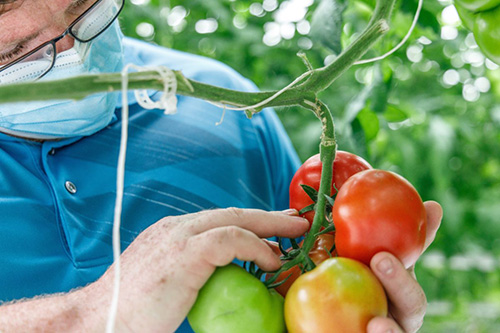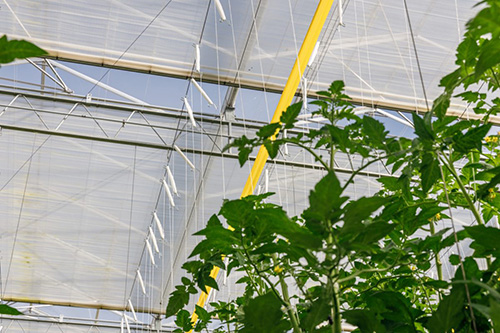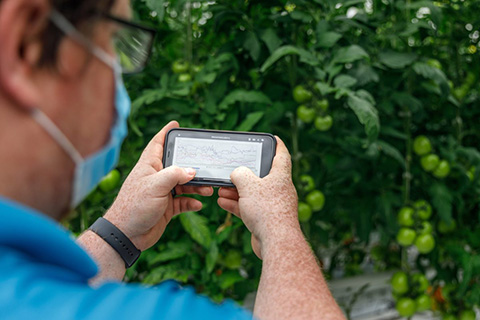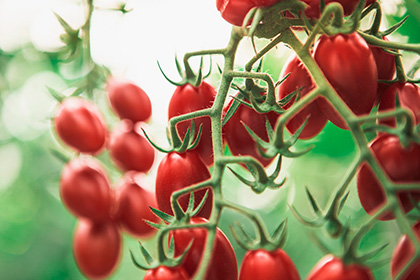We caught up with Head Grower Isaak Fast in Leamington for an in-depth tour so you can see exactly how Pure Flavor® vegetables are grown every day, 365 days a year.
With the winter season coming to an end, what was it like growing through the coldest months of the year indoors?
This winter season, we had a really good start to the year with a great crop. We have artificial lights in our new Phase II greenhouse that have helped us to grow a steady and consistent crop with a great end product coming off the vines.

Outside light levels can have an influence and levels have been very consistent all winter long. Our Beefsteak Tomatoes that we planted in September 2020 have been growing really well and will continue to yield delicious tomatoes until September 2021. Our first crop of cucumbers in Phase II, which we planted in October, is coming to an end. We are then replanting a new Cucumber crop that will take us forward into the summer. With the ability to grow crops year-round in Leamington, we have our hands full to ensure a consistent supply.
We had some cold nights in Leamington this February, dropping to below -20C at night. How do temperatures like that impact the crop?
The seasons outside don’t matter quite so much once you step inside a Pure Flavor® greenhouse – especially in Phase II under lights. We have a constant, consistent and stable climate even in winter that we control 100% with our integrated management systems.
How do you heat greenhouses efficiently during the winter?
It’s not like heating your home; we don’t use furnaces with forced air or even electric heat for that matter. Instead, we use high-efficiency water boilers that circulate hot water in tubes right where they’re needed: at the base of each plant.

Another added efficiency is that, like any heater, our water boilers produce carbon dioxide – but we use this carbon dioxide to help our plants grow. Plants are like lungs that transform the air they “breathe,” but, unlike human lungs, they absorb CO2 and transform it into oxygen. Through much of the year, we only have to run our boilers during the day so that the plants can absorb the CO2 while they’re active. We store hot water produced during the day in two 5-million litre tanks so we can heat the greenhouse all night without the boilers. Additionally, we use specialized energy screens to insulate our greenhouses while also regulating how much sunlight enters. It’s a really efficient process for maintaining a climate our vegetables can thrive in.
Can colder weather affect flavor, texture, and nutrition?
We can grow year-round and produce tomatoes from January through to December and ensure that it’s a very high-quality product. As far as the consumer is concerned, the product we get today is the same as the product we get in March June and October. Flavor, nutrients, appearance, texture – there’s no difference between our tomatoes or cucumbers grown throughout the year as we control every aspect of the growing process.
You mentioned you planted in Phase II this past fall. What’s growing and how does this crop look?
It’s an exciting time in the greenhouse – we have many different varieties coming to life in various stages of growth. Beefsteak Tomatoes, Tomatoes on-the-Vine, Cocktail Tomatoes, Long English Cucumbers and Nano Cucumbers are all growing right now. The quality we are seeing is really good! We had good amounts of natural sunlight all winter and that helped our supplemental lighting. In total, between Phase I and Phase II, we have plants that will produce over 26 million lbs of veggies.

That’s a lot of fresh veggies to manage. How do you keep track all these different crops that have their own requirements, grow times, pick times, water needs, light needs – all grown in the same space all year-round?
Technology is an incredible asset when it comes to managing the needs of our crops. We have a system that tracks climate, temperature and irrigation in the greenhouse. I monitor that system throughout the day to see the trends in real time, to check if we are venting, heating or watering enough. As a grower, I need to understand the needs of every plant – a beefsteak tomato has different needs than our nano cucumber plants – so I go out and monitor the plants myself to see how they’re reacting to irrigation, temperature and more. We need to create optimal growing environments: happy plants produce great product! If needed, I make changes based on what I see and what the computer data tells me. It comes down to attention to detail and comparing what we see with our own eyes with the data from our climate systems. Technology can sometimes only take us so far.

Talking about attention to detail, what are the details you’re looking for when inspecting each plant?
For example, we take plant measurements every week. We measure the thickness of the heads, the number of fruits that we set, the length of the leaves, the growth of everything on the plant and the size of the product itself that we pick. I take that data and compare to previous weeks and to benchmarks to ensure consistency. That’s how we deliver a product out to the customer with the consistency they expect and, to be honest, deserve from a greenhouse grown vegetable.
What exactly do those measurements tell you?
Just like us, we need balance between work and life – a plant needs balance too. By balance, I mean the ratio of fruit on the plant – the tomatoes or cucumbers we pick – to the vegetation, like leaves, flowers, and stems. Remember: for the most sustainable and efficient growing, we need our tomato plants to produce for roughly eleven months. If the plant isn’t balanced, it might produce a lot of tomatoes early on but then it might not have the vegetation to properly sustain it for the rest of the growing season. Is there a growing strategy? Absolutely! We need to make sure we are creating a positive environment for our crops to consistently produce the product.

What is the process for growing a cucumber plant from the time it arrives at the greenhouse to the time it is picked?
When a plant first arrives, we plant it in our growing media made of recycled fibers or coconut husks. We then push irrigation drippers into the media so they can start getting water & nutrients. The next step is to go to each plant and attach it to a string, so it grows upwards. Every other day we go back to the plant to twist it, clip it and prune it. Cucumbers typically grow up to 14 metres (40+ feet) long and our greenhouses aren’t 14 metres high. So, after the first couple weeks of harvesting from the bottom of the plant, we can start to lower the vines from the string so we can keep picking at a comfortable and ergonomic height.

What’s the benefit of lowering the cucumbers down to eye-level?
It’s much more efficient for us to lower the cucumbers to us and it’s much better for our team. When we can harvest 18 crates of cucumbers in a single row, we want to make the cucumbers we’re picking as easy to access as possible.
What are the differences between growing cucumbers and tomatoes?
Cucumbers require quite a bit more water than tomatoes and they each have different nutrient requirements that we need to monitor. Another difference is that, for tomatoes, we have bumblebees that help us naturally pollinate. Cucumbers, meanwhile, are self-pollinating. That means they have male and female flowers on each plant – so they don’t need bumblebees to help out. Interestingly, the cucumbers themselves are part of the female flower! Another big difference is how quickly cucumbers grow. Our Nano Cucumbers are ready to start picking less than two weeks after planting – and they grow so quickly we actually have to pick twice a day!

Pure Flavor® greenhouse grown vegetables are known for their great flavor. In your opinion as a grower, what’s the magic recipe for getting great flavor out of these plants?
The two things that contribute most to that amazing flavor is plant nutrition & climate. Our 24-hour temperature, night-time temperatures and daytime highs all need to be monitored closely to bring customers that consistency in flavor. All the technology in our greenhouse is there to create the perfect environment to bring out the flavor in each variety we grow, regardless of the season.
There’s a new grape tomato you’re growing this year – the award-winning Cloud 9®. Where does that award-winning flavor come from?
There’s a reason why we say Cloud 9® Tomatoes are “a tiny taste of heaven™” and you’ll know as soon as you taste one for the first time.

We’ve carefully selected this variety because it is so much sweeter and grows well in a closely controlled greenhouse environment. You definitely couldn’t grow a product like this outside of a greenhouse where there’s no control of climate or precise irrigation. You need that precision that comes from advanced technology. We have strict quality control to make sure every tomato that gets shipped out is consistent. In every pack we ship out across the country, we want to ensure that consumers will enjoy the sweetness they crave and the quality they deserve.
How do you ensure that consistency?
We have trained specific team members to harvest them according to specific guidelines, looking for those markers of quality. We closely monitor them to ensure only the ones meeting that criteria are picked. The Cloud 9® Standard is always on our minds – everyone knows that picking the highest quality tomatoes is our top priority every morning when we get to the greenhouse. Each tomato needs to be perfectly ruby red and to have that iconic shape. We may or may not taste test quite a few of them, too – just to make sure that fruity sweetness comes through.

It’s exciting to see a premium greenhouse grown product like Cloud 9® receive such attention – from chefs, consumers, trade partners. So, naturally, I have to ask: what’s next?
That’s top secret! But I can say that there are exciting times ahead. We’re always testing new varieties that we think consumers will love. Our acreage continues to grow – Phase III is well on its way and will be completed in late summer for us to plant in early Fall 2021. There’s a lot to look forward to here in Leamington!



